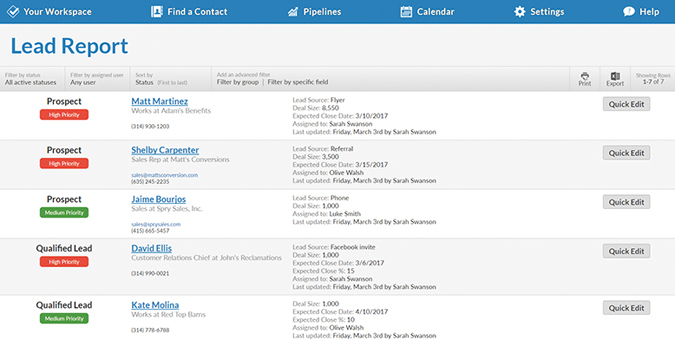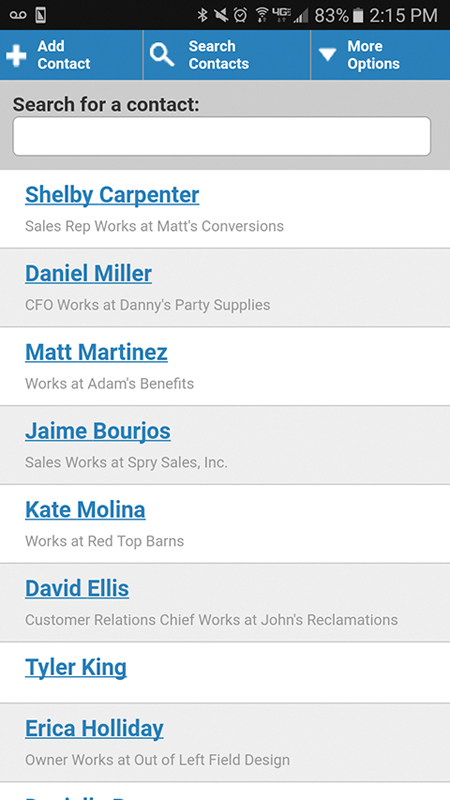
As the co-owner of a busy water features company, I know how hard it is to keep track of potential work while keeping in touch with current customers. As recently as last winter, my husband would come home from working in the field and ask me who had called that day, and I would have a piece of paper with notes written all the way around it in tiny words, none really making sense. It was very confusing — and not very helpful to our company!
If I wanted to see what we had charged a customer for a cleanout, I would have to check at least two, if not three places to find out. I’d go to the Excel spreadsheet, the Excel “master list” spreadsheet, the cleanouts spreadsheet and QuickBooks. There had to be an easier way!
The Answer Becomes Clearer
Last winter, I was talking to a friend who is also in the pond industry, and she heard my problem. “You need Less Annoying CRM!” she declared. What was that? I kind of knew what CRM was — customer relationship management — but what made it less annoying?
In my previous life as a marketing consultant, for many years and for many larger companies, I knew the importance of a database. But I hadn’t seen software made specifically for pond builders. Nor did I know how easy it would be to personalize it.
I quickly logged on to Less Annoying CRM (www.lessannoyingcrm.com), which is called LACRM for short, and I fell in love! It truly was less annoying. It was so easy to use. The first thing I did was export my data from QuickBooks and import it into LACRM. It took me just a few minutes. From there, I began exploring the world of LACRM.
Everything starts at the same level in LACRM — with contacts. You customize your data sheet for contacts any way you want to limit your request to what you are seeking. Then the fun begins.
Things are divided into two main areas — pipelines and groups. There are many explanations on the differences, but as it says on the LACRM website:
“Groups are good for tracking some sorts of things, but not so good for others. Groups are a list-building or contact/company segmentation tool — they are good for keeping track of a shared quality between a group of records in your database … Pipelines are a way to track a project from first phone call to thank-you letter. They have comprehensive reporting tools for you to follow the process over time. Pipelines allow you to build out a custom workflow, track the contacts through that workflow, enter notes along the way and even create custom fields to capture additional workflow-related information.”
These are both very important, because they allow us to track a job in a pipeline. Everything is customizable as well.
How a Pipeline Works

customer, allowing you to add them to various lists and pipelines.
Let’s say Mark Smith reaches out to us as a potential customer. I put in his information as a contact in LACRM, and then we add him to our leads pipeline. I can customize this to give me just the information I need or want. So, in addition to name, email and address, I can note how each customer found us with a list of all my referral sources, and what kind of work they wanted done. I can also track my lead — it starts as “qualified lead” and then might move to “waiting for photo” or “appointment set.” This way, when I look at our leads, I know right away where we stand with everyone.
Then, the lead eventually closes as either a win or loss. When it’s a win, we simply put the customer in the next pipeline. I have pipelines for fall, summer and spring cleanings, signed clients and even a pipeline for thank-you notes.
This enables me to follow each lead all the way through. We have made a lot of money this year by being proactive and following all leads. We are also able to track all our leads this way. For example, I know we had 97 Google leads this year.
LACRM Groups
Beyond pipelines, I rely on LACRM for groups, which then merge seamlessly into MailChimp. I put customers in different groups, such as “people I want to get our pond tips each week,” “hardscaping clients” and “everyone.” (The group labeled “everyone” gets our monthly newsletter.)
The groups then merge with MailChimp into their lists so I can reach out to each dedicated audience. I can send an email to hardscape clients or seasonal customers quickly and efficiently.
One More Puzzle Piece
The final piece in my puzzle is MailChimp’s automation campaigns. As MailChimp says about its automation campaigns:
“Send an on-boarding series to introduce new subscribers to your business or organization. Automatically follow up with customers after a purchase and recommend other products that they’ll love. Surprise your best customers with a coupon triggered by their shopping behavior. Remind customers of the products they’ve left in their cart and encourage them to complete their transaction. Re-engage inactive subscribers.”

I currently use automation campaigns in two ways. First, I created a welcome series campaign. This is a series of five emails that start going out right after I put a potential client’s email in the list. Each added email address will get a series of introductions already written about our business — a total of five over five weeks. For example, we sold a $14,000 new pond installation by using this method. We got a lead on a Sunday night. I activated the emails while still eating dinner, and the customer was learning about us within minutes. When I spoke to him the next morning, he said we were the only people who got back to him right away, so we were hired! In addition, through the email series, he learned we did hardscaping and hired us for a hardscaping job as well.
Second, I have a customer follow-up series sent three days, three weeks and three months after we complete a job. Through emails, we check in on customers and ask how they are doing, and then ask for a Google or Facebook review as well. We include a link to our price brochure in our last email to get people thinking about their next project.
Emails
Each new customer is added to one or more groups or lists in MailChimp. We send out two items regularly: our monthly email newsletter with links to our blogs, leading industry blogs, helpful hints and before-and-after photos, and our weekly pond tip. This way, we know we are communicating with each customer regularly. For example, last year we sent out our newsletter and received a reply from one of our clients. He kept meaning to tell his financial client about us, but he forgot. Then the monthly email reminded him, and he made the introduction. We built a $63,000 pond for his client referral. This stuff really works!
Overwhelmed Yet?
Don’t be. It’s not as complicated as it sounds. And when you are finished setting up your systems, everything will be much easier to run, and you will make a lot more money. Organization and communications are key to running a successful business, and these programs truly help.


